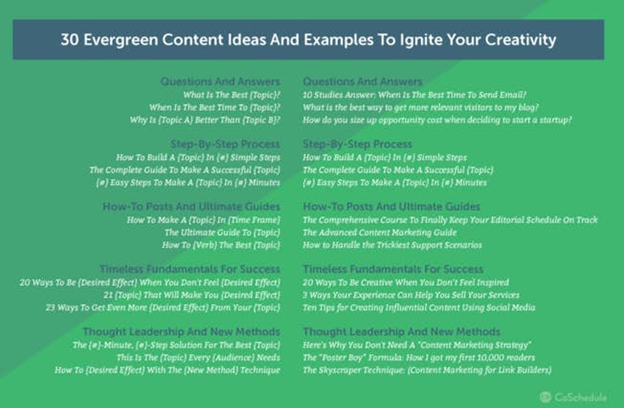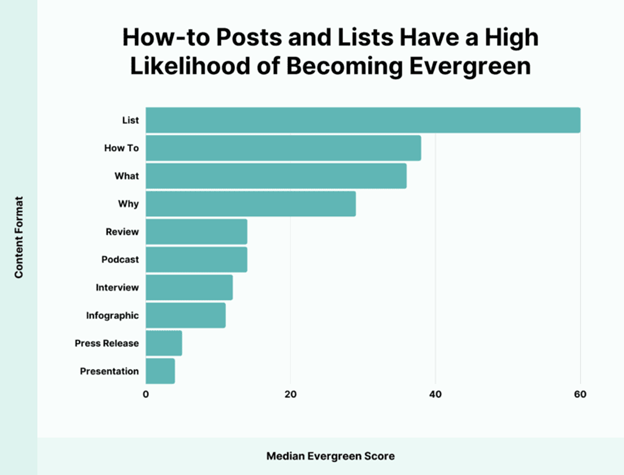Writing SEO-friendly content that holds up for years is safe, smart, and efficient. This is called evergreen content or sustainable content.
It’s vital to your search engine optimization (SEO) efforts because it includes valuable content inclusive of your keywords.
Both are things Google loves, and your audience will too.
Today we’ll go over:
- The ins and outs of evergreen content
- Why it’s so important to your content marketing strategy
- How to create sustainable content
When your evergreen content is done the right way, it can lead to years of revenue and leads.
Let’s dive in…
Using Evergreen Content
Timeless content, by design, is meant to prove relevant, educational, and engaging for years.
True, things change, and your content may need to be updated here and there, but in general, this kind of content should stay, more or less, on point throughout time.
Content written with this in mind means minimal effort and not having to continuously recreate the wheel.
Your articles, lessons, how-tos, e-books, whitepapers, and more will provide your audience with excellent, purposeful, reliable information that lasts.
Some examples of evergreen content include:
- Recipes: The ultimate lemon chicken breast
- How-to posts: How to eat healthier- for good
- Lists: The 3 best exercises for a sore back (and how to do them)
- Guides: The ultimate guide to creating a podcast
Other examples include:
- Case studies
- How-to for beginners
- How-to for experts
- Checklists
- ‘Greatest of’ lists
- Mistakes to avoid lists
- Best practices
- All you need to know about ____.
Content that remains true for years often involves some kind of list or guide that delineates how to make something or how to make something happen.
Why is evergreen content important to your content marketing strategy?
Your content marketing strategy should be full of content that attracts and retains your audience.
The pieces should entice shares, likes, clicks, and comments while encouraging your users to take the action you want them to (buy this, download that, book now, etc.).
This is done by creating engaging, relevant content and can be in the form of blog posts, articles, videos, podcasts, and more.
Your content should be:
- Informative- full of your experience and knowledge
- Engaging- inviting connection, reaction, shares, etc.
- Self-promoting- offers brand awareness to your audience
All of this should be true for all of your content; however, for your evergreen pieces, it’s this, plus relevance-retaining and traffic-driving long after its original publication date.
No time-sensitive content is ever considered evergreen.
Examples of time-sensitive content include:
- Blog posts about the seasons: Halloween costume ideas
- Articles about upcoming events
- Content regarding current events
With evergreen content comes a level of confidence in your brand, and when you become a go-to resource for information, you’ll get the nod you’re looking for from the search engines.
E-A-T stands for expertise, authoritativeness, and trustworthiness, and it’s something Google considers when deciding where to rank a website. If you’re considered an authority, you rank higher, and evergreen content helps with that.
It also contributes to getting you organic (non-paid) website traffic which is a huge SEO win and gets patients through your doors.
How to Create Content That Stands the Test of Time
Knowing how to create sustainable content is going to save you time and money. It’s really as simple as that. So, let’s give you some quality info on writing evergreen content.
Topic
Your topics matter, so when writing for your evergreen content strategy, be sure you choose wisely.
Writing about a trending topic, such as how to prepare for the marathon coming up in your community that will raise money for the fire station, is an excellent way to pull in some visitors by using keywords surrounding that event. However, that level of interaction will be fleeting.
Writing about how to prepare for an athletic event, on the other hand, will offer a much better chance at staying relevant for years.
Keywords
Your content pieces hold different values, and, like stated above, knowing when, where, and how to use your keywords to get you traffic is critical.
If you’re writing sustainable content, you don’t want to mention anything about a current event or a specific time.
Time element
When adding dates, times, and current events to your content, you’re essential nullifying its place as an evergreen contestant.
It’s okay to do this, and it should be done; you want to keep your users up-to-date whenever appropriate. Just know that the piece of content likely won’t be getting lots of hits in the future.
The kind of content
As mentioned above, certain kinds of content pieces get more evergreen traction:
- Tutorials
- Guides
- Lists
- How-tos
This kind of content is more likely to continuously see traction.
Remember to write for beginners so everyone can understand what you’re saying, you want to appeal to a large audience. And don’t use extremely technical language. You may alienate your readers.
Repurposing of content
When you see that one of your pieces is getting a lot of attention and has been for weeks, months, or years, and your users are hitting on your CTA (call-to-action), you’ve got an excellent opportunity to repurpose something you know is set up for success.
Here are some ideas to turn that stellar piece into more stellar pieces:
- Turn a blog post into a podcast
- Write a guest blog post
- Make some social media posts linking back to the piece
- Create an infographic
- Create a video
Using these guidelines, you’ll be able to create long-lasting content right from the start.
Regularly Updating Content & Promoting It
While all of the above-mentioned ways to support your sustainable content are necessary, regularly updating your content and effectively promoting it are just as important.
Updating content
Don’t forget to ensure your evergreen content is just that: evergreen. It must remain true and provide value to your user.
Sometimes, a new, more relevant idea or item, or specification must be added to your existing content to keep it up-to-date.
In most cases, updating content is very quick, as the vast majority of your existing piece is still valid.
Don’t underestimate the importance of doing this; by not updating a small portion of a well-received article, you may miss out on all the goodness that article can provide in the future.
By adding new stats, updating or adding images and videos, giving more and new info, and adding better keywords, you’re ensuring the piece stays trustworthy, helping it receive more recognition and casting a wider net over your readers.
Promoting your content
Last but not least, don’t forget to promote your content. Both new and old. Tell your users about your new article or podcast!
You can do this in several ways:
- A newsletter
- An email
- On social media
- On other pages of your own website
- Influencers
- Guest blogging
The point is to meet your audience where they are and invite them to come to where you are (where your content is, more specifically).
Even with updated pieces, you want to be sure to promote the new information you’ve added.
This is a great way to get new and old users to come and give you some attention.
Don’t forget to:
- Ensure sharing is easy for the user
- Ensure commenting is on
- Answer comments and questions (good and bad)
- Link to other relevant articles
Put Your Evergreen Content to Work For You
Evergreen content not only improves your SEO, but it helps inform your users, which helps to define you as an expert, which helps get you authority which improves your SEO. See what happened there? Full circle.
We’d love to talk with you more about your content strategy and how it can maximize your SEO efforts. Book a call, and let your journey to the top of Google commence!






![How to Write a Professional Chiropractic Bio [Template Included]](https://propelyourcompany.com/wp-content/uploads/write-a-bio-500x383.jpg)

